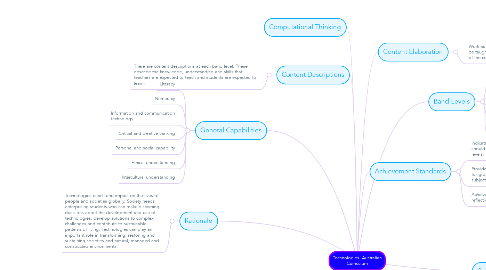Technologies- Australian Curriculum
作者:Nikki Adams

1. General Capabilities
1.1. Literacy
1.2. Numeracy
1.3. Information and communication technology
1.4. Critical and creative thinking
1.5. Personal and social capability
1.6. Ethical understanding
1.7. Intercultural understanding
2. Student Diversity
2.1. Students with a disability
2.1.1. Teachers can draw from content from different band levels.
2.1.2. Teachers can use extended general capabilities learning continua to adjust the focus of learning to the individual student's need.
2.2. English as an additional language or dialect
2.2.1. These students may need additional time and support as well as a greater focus on their language needs.
2.3. Gifted and talented students
2.3.1. Focus on cross-curriculum priorities.
2.3.2. Emphasising specific aspects of the general capabilities learning continua.
3. Cross-curriculum Priorities
3.1. Sustainability - Links to key idea of creating preferred futures.
3.2. Aboriginal and Torres Strait Islander histories and cultures
3.3. Asia and Australia’s engagement with Asia
4. Content Descriptions
4.1. There are content descriptions at each band level. These describe the knowledge, understanding and skills that teachers are expected to teach and students are expected to learn.
5. Rationale
5.1. Technologies enrich and impact on the lives of people and societies globally. Society needs enterprising students who can make discerning decisions about the development and use of technologies, develop solutions to complex challenges and contribute to sustainable patterns of living. Technologies can play an important role in transforming, restoring and sustaining societies and natural, managed and constructed environments.
6. Computational Thinking
7. Curriculum Aims and Objectives
7.1. For students to be creative when using different forms of technology and understand how technologies have formed over time.
7.2. For students to select appropriate technologies and resources when creating products and digital solutions.
7.3. For students to critically evaluate technologies processes to identify problems and create solutions.
7.4. For students to investigate, design, plan, manage, create, produce and evaluate technologies solutions.
7.5. For students to engage confidently with technologies and make informed, ethical and sustainable decisions about technologies for preferred futures.
8. Subjects
8.1. Design and Technologies
8.2. Digital Technologies
9. Strands
9.1. Knowledge and Understanding
9.2. Processes and Production Skills
10. Key Ideas
10.1. Creating preferred futures - focuses on systematic thinking to develop the knowledge, understanding and skills to move towards ethical, socially responsible and sustainable patterns of living.
10.2. Project Management - includes planning, evaluating, developing resources, decision-making and communicating with others.
11. Content Elaboration
11.1. Work as support materials to illustrate what is to be taught and to provide a greater description of the content descriptions.
12. Band Levels
12.1. Foundation to Year 2
12.2. Year 3 and 4
12.3. Year 5 and 6
12.4. Year 7 and 8
12.5. Year 9 and 10
13. Achievement Standards
13.1. Indicates the level of learning that should typically be met at certain band levels.
13.2. Provides teachers with a framework or guide for growth and development within each subject.
13.3. Achievement standards for Technologies are reflective of the practises within each subject.


